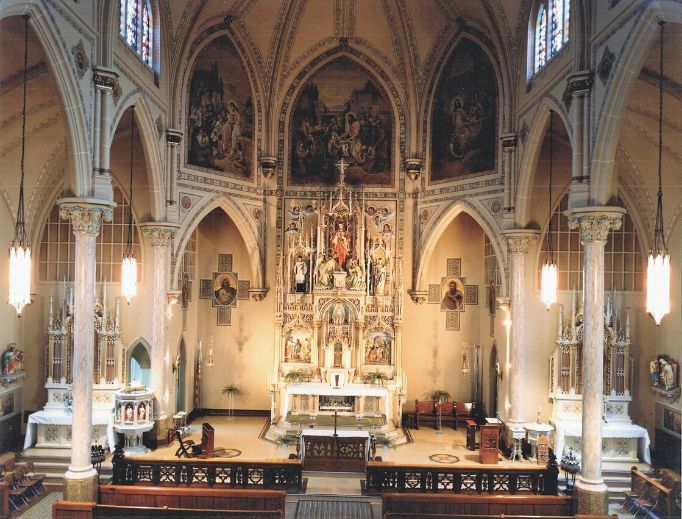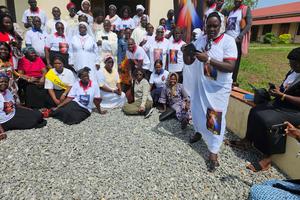How 1 Parish Celebrates Divine Mercy All Year
Welcome to a special church in Bellevue, Kentucky.

Three years after St. John Paul II officially declared the Second Sunday of Easter as “Divine Mercy Sunday” for the universal Church in the year 2000, Divine Mercy parish was officially formed in Bellevue, Kentucky. In this city just across the Ohio River from Cincinnati, the Churches of Sacred Heart and St. Anthony of Padua (whose edifice was sold) merged to form this new parish under the patronage of Divine Mercy. The parish honors the Divine Mercy message with not only its name, but with a devotion to Divine Mercy that spans the entire year, all in a church with great historical significance.
The history accounts for the church itself retaining the name of Sacred Heart Church. Father Martin Pitstick, the pastor, explained that even though the parish name changed with the merger, under canon law if a church building has had a name for 100 years, the name can’t be changed. At the same time, Sacred Heart (first in German as Herz Jesu Kirche, attesting to its earliest congregations) is listed in the National Register of Historic Places.
In 1874 the German immigrants to the city built a small church. As the parish grew, they needed a larger church — this current edifice. Building began in 1892 and was soon completed as a Gothic structure, with flying buttresses, to look like a church in Bavaria. The style gave the congregation, mostly made up of immigrant and first-generation Germans, a feeling of “home-like” comfort. In 1915, a windstorm damaged the steeple, once the tallest in northern Kentucky. Today’s steeple replaced it, complete with its octagonal copper dome.
For the church’s golden jubilee, the pastor at the time embarked on a two-year renovation project to mark the occasion. For one, he had the original brick-faced church overlaid with today’s prominent imitation Indiana limestone.
Inside, the beauty of the church’s significant renovations for that 50th anniversary in 1924 immediately draws eyes to the sanctuary and the side shrines, with their spiritual and artistic magnificence. Father Pitstick explained to the Register that the renovations were the work of Father Aloysius Roell, pastor of Sacred Heart from 1917 to 1932.

Three majestic altars for the sanctuary and side shrines were all hand carved in western Austria, showcasing ornate designs of Gothic arches, filigrees, tracery, niches, spires and more. The reredos for the main white high altar soars to 33 feet and widens to 16 feet, shining in abundant gold trimmings. On either side of the central tabernacle, carved bas relief scenes in their own niches show Jesus feeding the multitudes with the loaves and Moses getting water from the rock.
Higher still, two angels holding symbols of Jesus’ crucifixion adore the life-size Sacred Heart in the highest and largest of niche-shrines on the reredos, while to either side below the depiction of Our Lord stand large images of St. Aloysius and St. Agnes. Her name in Latin means “lamb,” explained Father Pitstick, who is also pastor of St. Bernard Church in Dayton, Ohio. St. Aloysius’ appearance is likely because he was the patron saint of the pastor at the time.
Standing to either side between the sanctuary and side altar shrines are three-quarter-size images of St. Thérèse and St. Anthony. Then come the wondrous side altars, one dedicated to our Blessed Mother and the other to St. Joseph. The side altars with the statues of Joseph and Mary rise a towering 19 feet high by 8 feet wide. Each altar shrine mirrors in a smaller version the main altar’s ornate niches, arches and filigrees, highlighted in gold. The 1930 pulpit is no less beautifully carved. Jesus and the Four Evangelists each stand in a gothic-arch “shrine” with Corinthian columns between them.
At the rear of the nave stand a pair of colorfully polychromed shrines that were carved in Munich for the parish’s golden jubilee. The first carved in near full figure presents the Pietà — which depicts our Sorrowful Mother holding the body of her Son and our Savior Jesus. In contrast, next to this shrine there stands a lovely statue depicting St. Anne with her young daughter. The figures are three-quarter life size.
Across the aisle, the elaborate three-quarter bas relief and highly colorful Purgatorial Shrine presents a priest saying the Tridentine Mass, holding up the Host toward Jesus crucified, while to the altar’s side, purgatory is open, revealing poor souls who await release. An image of an angel brings one soul to heaven while another angel holds a chalice to catch the blood from our Crucified Savior. This shrine reminds visitors of how the Mass applies the merits of Christ upon the cross to help souls in purgatory reach heaven more rapidly.
It’s as if the church unknowingly anticipated the new future parish name of Divine Mercy, considering this shrine’s message. Likewise, the pair of votive candles that stand before each shrine are shaped like hearts — a reminder of the Sacred Heart of Jesus and the heart of Jesus as the Divine Mercy streaming rays of white and red.
The shrine of Divine Mercy was added after the merger into Divine Mercy parish. Jesus appears not in the familiar paintings of the Divine Mercy but beautifully depicted in a nearly life-size statue, beautifully hand carved and standing within a decorative shrine of oak.
Father Pitstick noted that the pastor who commissioned the statue intended it to replace the one of the Sacred Heart on the reredos. When it proved too big, this new shrine was necessary. One panel of this shrine includes an image of St. Faustina; below it is a reliquary containing a relic (a piece of her bone).
The golden jubilee also saw more beauty added in the form of exquisitely carved and polychromed Stations of the Cross. These were done in Dusseldorf, Germany.
At the same time, murals were added around the church. A renowned fine artist of the greater Cincinnati area, Leon Lippert, lined the walls with murals depicting scenes from the life of Jesus, such as the Flight Into Egypt and Meeting the Woman at the Well. The theme continues in the three large frescos high in the apse showing the repentant woman washing Jesus’ feet, Jesus healing the sick and Jesus speaking to and blessing the children, and the medallions on the sides of the sanctuary are the work of artist Theodore Brasch.
In 1950, the original stained-glass windows were replaced. With highly colorful glass imported from England, Germany and France, a Wisconsin company handcrafted the new hand-blown glass windows. The designs reflect a German feeling in the artistry of their design and overflow with various symbols of the Catholic faith, such as a Marian window with a gold crown and a heart aflame.
What would a Divine Mercy parish be without a devotion to Divine Mercy? This parish continually celebrates the Divine Mercy. Usually, every Tuesday at 3pm the Divine Mercy Chaplet is prayed, followed by adoration, Benediction, Mass at 5:30 and then confession; the parish schedules confession seven days a week.
Although the parish does not have the ability to livestream, people are referred to the cathedral online and televised Mass, including on EWTN (a link is on the parish website), during this time of pandemic. As of press time, the church remained open daily for exposition (times are posted online). And Father Pitstick prays the Chaplet of Divine Mercy daily at 3pm.
Fittingly, one of the church’s two bells is inscribed Hertz Jesus Gloke, which means “Heart of Jesus Bell.” When rung, it can be heard around the city, calling people to come to Sacred Heart Church, where Jesus, the Divine Mercy, awaits.
Joseph Pronechen is a
Register staff writer.
Online: DMSBCatholic.com
- Keywords:
- divine mercy
- joseph pronechen
- travel

















